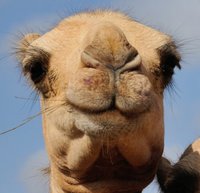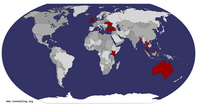COMING SOON HOUSE ADVERTISING ads_leader
Rajashtan was once ruled by the famous Rajputs - self-indulgent rulers who built immense forts and amassed larges fortunes and harems. Though their rule has finished, their legacy lives on in the myriad of fortress towns scattered across the bleak landscape - some of which are known by the predominant colours used in their construction.
Created by Maharwal Jaisal Dev (1156-1167) Jasialmer is known as the "yellow city", due to the yellow and golden sandstone used in its fort - and it looks like an enormous sandcastle emerging from barren plains. The city is close to the Pakistan border (under 100km) which manifests itself by the numerous jet fighters from the Indian Air Force roaring overhead. I arrived at the city at 5am - and the dimly lit, fog enshrouded, twisted cobble-stoned streets were empty, except for yapping dogs and gently lowing bovines. It felt like I was stepping back in time - and is one of the most memorable arrivals in a new city I can ever remember.
However, the hoards of tourists and the visiual pollution of countless advertising signs saying "Internet", "Hotel", "Restaurant" and "Handicrafts" did detract from the ambience of the place somewhat. It did have a lovely palace, which has been the home of the city's rulers for centuries (including Maharawal Kehar 1361-1396 who had 21 Queens - though the average Queens per ruler was a more modest 8), and the locals were very friendly - who kept approaching me in the street to provide updates on the Australia-New Zealand test match in Brisbane.
While here, I engaged in the obligatory camel experience by embarking on an overnight camel safari into the Thar Desert. I boarded one of the ubiquitous Rajhastani camels - this one called Mateas - who was definitely the smelliest camel I have ever sat upon. My trusty handler, Papu, led me through a curious landscape of shrubs and spindly cacti, as we passed lines of goats, whose symphony of bells and occasional bleating provided the only noises of this place. We visited villages where women sheltered behind coloured veils, and children peered at me from behind dusty darkened faces. I noted that we always disembarked from my camel before entering a village, so deduced it was obviously a custom not to ride a camel into a populated area.
After half a day of riding, which made me discover muscles that I never knew I had, I arrived at a series of sand dunes where we were joined by another group of 7 tourists - complete with camels and handlers. Following dinner, I lay my blankets on the sand and lay beneath the stars - listening to the camel handlers singing nomadic songs whilst I tried to dissuade a persistent dung beetle from inhabiting my bed. My most enduring memory though was of a solitary camel silhouetted against a moon-lit sand dune - quite magical. Once the moon set, the stars were illuminated to their full brilliance with hues of red, yellow and blue, whilst scores of shooting stars filled the sky with activity - quite a magnificent sight. In the morning the sand around my desert bed was filled with animal tracks - notably desert mice and dung beetles - so I was obviously a curiosity to these nocturnal creatures. A few hours after breakfast, our safari was over, and when we arrived in town, a local sniffed the air as we walked passed and said "camel smell" so we certainly did have a terrible odour - but it was a small price to pay for the privilege of sleeping beneath the stars.
Jodphur is known as the "blue city", not because of the colour of the fort, but because the majority of square shaped homes in the town are painted a bright sky blue - supposedly it was the colour of the brahmins, but now everyone is allowed to paint their house this colour - and the locals believes that it helps keep away the mosquitoes as well. The fort here is the aptly named Mehrangarh, or Mighty Fort, and it is certainly a fort which induces one to use a constant stream of superlatives. Constructed in 1459, it has the honour of being a fort that was never overrun - helped by ingenious methods such as having the main gateway at right angles to the main entrance path, so elephants could not build up enough momentum when attempting to charge the door down.
Rudyard Kipling said of Mehrangarh that it was the "work of angels and giants" and without a doubt it is the most impressive fort or castle I have ever visited. The sheer scale of the towering walls perched precariously on perpendicular cliffs over 120 meters above the town is breathtaking. The inside was equally striking - the Phul Mahal or ceremonial room was dripping in gold tiling, ornate designs and archways resplendent with incredibly fine details. Palaquins used to carriage the royal persons were also sumptuously ornamented with gold, and everywhere you looked, the fort oozed the incredible wealth that made the Rajputs famous.
Walking outside the fort, one had sweeping views over the myriad of blue coloured homes. The hawks that circled were at eye level and we literally had a bird eyes view of the world below. Despite the height we were at, the gentle desert winds would lift the sounds of the city to the castle walls - so you could hear music, people singing, traffic noise, and the wailing cry of the mosque as if it was within a few metres. I could just imagine many centuries ago when the rulers would walk the ramparts - and they could hear all the sounds of their loyal subjects rise to their ears. Truly, this is a fort that commanded the world it surveyed - and with such a view - this was certainly an impressive boast. The morning spent striding through Mehrangarh Fort is definitely the highlight of the coloured cities of Rajashtan.
The final coloured city is that of Jaipur, or the "pink city", though I feel that ochre or peach is a more apt description for the colour of its palace and old city. Being a city of over 2 million people means that the older buildings have been subsumed by the sprawling metropolis surrounding it, but still the palace had a majesty all of its own. There were finely wrought pieces, including the four famous doors which are each crafted after a season of the year. The most famous of these are the glittering peacock entrances, complete with gold doors and brilliant carvings of peacocks tiled in blue surrounding it. There was also the largest silver vessel in the world (actually there were two of them) - it weighed 250 kg, stood 1.5 metres tall, and used to contain water from the holy Ganges river - and I thought it perfectly summed up the immense wealth and indulgence of these rulers.
However, the highlight of Jaipur was the city itself rather than its monuments - especially the shopping, and I was fortunate to have some fellow shoppers to encourage me in my purchases. During my last day in Jaisalmer, I met Shivani (from Kenya) and Lindsay (from Canada) and we have been travelling together during the last few stops in Rajahstan. It is really great that people from three continents have come together to see the sights of a fourth - truly an international experience. Anyway, we all decided to do a shopping splurge in Jaipur - and after visiting clothes shops, shoe shops, jewellers and bag shops - we ended with a vast array of goodies - mine amounted to a traditional Indian men's outfit (the kurta pyjama), complete with jootis - the traditional pointed shoes of Rajasthan.
One night though, we made the mistake a taking an autorickshaw ride with a crazy driver called Ali. Now, Jaipur's roads are very frenetic places - cars, buses, taxis, autorickshaws, rickshaws, camels, elephants, pigs and goats all vying for a precious piece of road - but with Ali at the wheel, it became an experience that rivals the most thrilling theme park ride in the world. Going to dinner one night, Shivani, Lindsay, and I found that the restaurant of our choice was closed, and Ali suggested a place we had just passed - so he turned around and, not bothering to cross the road to the other side - drove directly into oncoming traffic - with his headlights off. We careered forth, missing other vehicles and pedestrians by centimetres, the young ladies were squealing in horror and I was visibly aging as we swerved violently left and right to avoid a head-on collision. Then in a manoeuvre which saw us cross three lanes of traffic in under a second, we finally arrived at the restaurant. Ali then boasted to us that "I am a funny guy", but we were not of the same impression as we walked away, still shaking from the most hair-raising experience of these holidays.
COMING SOON HOUSE ADVERTISING ads_leader_blog_bottom
Tot: 0.096s; Tpl: 0.015s; cc: 13; qc: 28; dbt: 0.0484s; 1; m:domysql w:travelblog (10.17.0.13); sld: 1;
; mem: 1.1mb














